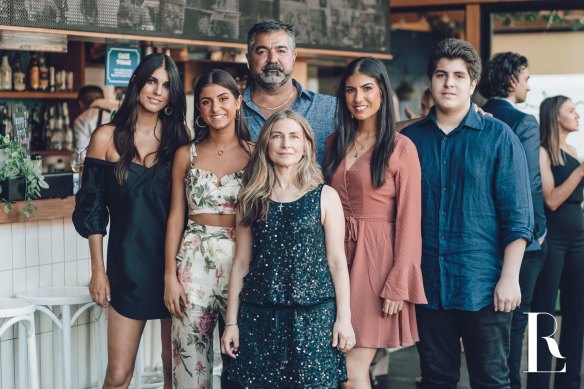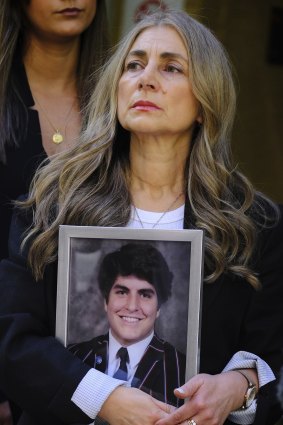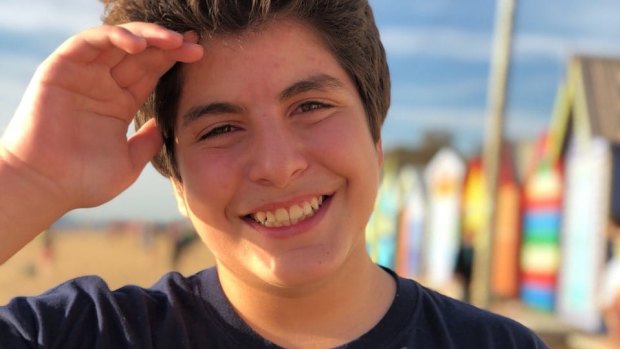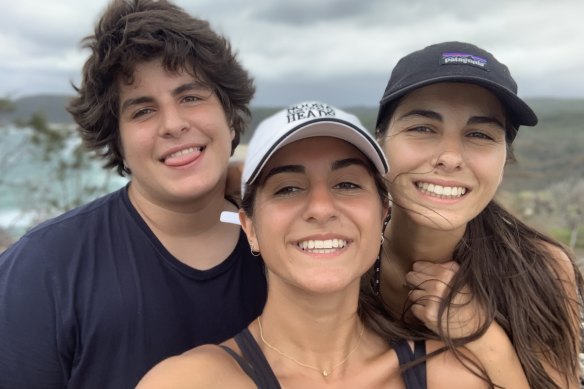This was published 9 months ago
Wheeze should have been red flag, inquest into teen’s death hears
In his final moments of consciousness, James Tsindos had developed a wheeze. He told healthcare workers at Holmesglen Private Hospital he was struggling to breathe and wanted his mum.
The 17-year-old’s deterioration happened suddenly. Within 20 minutes of arriving at the hospital by ambulance, James went from experiencing seemingly mild symptoms, linked to a nut allergy, to a cardiac arrest.

James Tsindos’ father, Harry Tsindos, outside court with a photo of his son. Credit: Luis Enrique Ascui
On Friday, expert witnesses Associate Professor Warwick Butt, an intensive care consultant and globally decorated clinician, told an inquest into the teenager’s death that James’ wheezing and use of his asthma puffer on arrival at the hospital should have been a red flag for healthcare workers to immediately escalate his care.
“It’s my view the wheeze was a progression of disease,” Butt, who is based at Melbourne’s Royal Children’s Hospital, said. “His condition was likely to become very severe, very quickly. He needed immediate treatment.”

James Tsindos with his parents and sisters.
Coroner Sarah Gebert is examining the medical care the teenager received after he suffered an anaphylactic reaction to a burrito bowl he had ordered from a restaurant via an online food delivery app on May 27, 2021, to determine if anything could have been done to save his life.
Unknown to James, who had a tree nut allergy, the bowl contained cashews.
James, who was completing year 12 at Brighton Grammar, had a history of allergic rhinitis and asthma and noticed his lip swelling, tingling in his throat and abdominal pain shortly after eating part of the burrito bowl.
The inquest heard his father called an ambulance, which arrived within 11 minutes. Paramedics administered two adrenaline shots within five minutes of each other and initially believed James had responded well, with the teenager saying the tightness in his throat had subsided.
But as he was being wheeled through the doors of the hospital, in Moorabbin, James told the paramedics he was “wheezy” and the court heard he used his asthma puffer more than a dozen times.

James’ mother, Venetia.Credit: Luis Enrique Ascui
As he deteriorated, he was placed on oxygen therapy and given adrenaline, but he continued to struggle to breathe.
An emergency code blue was declared as James went into cardiac arrest and staff made desperate attempts to resuscitate him over 40 minutes.
James never regained consciousness. Five days later, his family would be at his bedside when his life support was turned off.
On Friday, his mother, Venetia Tsindos, sat in the front row of the Coroner’s Court, clutching a photo of her dead son, a talented pianist who dreamt of studying music and entrepreneurship and wanted to travel the world.
Beside her was James’ father, Harry Tsindos, and his three sisters. In the rows behind them, the teenager’s school friends, dressed in white shirts and their school ties, packed into the courtroom, which was full of photos of James’ smiling face.
The inquest heard on Friday that there were varying accounts over whether James’ wheezing was detected and dealt with appropriately by paramedics, nurses and doctors.
The inquest heard he was triaged as a category three patient when he arrived at the hospital, which requires treatment within 30 minutes.
There are differing accounts of whether paramedics told nurses about James’ wheezing, the court heard. Butt described this as a “sliding doors moment”.
James’ care was complicated by the fact he was awaiting a coronavirus test, and he was later diagnosed with respiratory syncytial virus, a potentially serious illness that can cause pneumonia.
Butt said James had “every major risk factor for severe anaphylaxis” including a long history of asthma and a known nut allergy involving cashews, which have been increasingly associated with death.
“He has also an intercurrent infection so they’re all grave … predictors of worse disease,” Butt said.

James Tsindos
The court was told James is believed to have experienced “biphasic anaphylaxis”, meaning two episodes of anaphylaxis.
Butt said he was concerned by the fact 48 minutes passed after James’ second adrenaline shot, which was given to him by paramedics, meaning the treatment used to tackle life-threatening allergic reactions was wearing off.
Asked if he believed James’ death was preventable, Butt said: “I think with more timely treatment he would not have died.”
In a statement on behalf of James’ family, their lawyer, Shari Liby, said James was a beautiful teenage boy.
“He was a boy filled with laughter and joy and hope and his family are devastated by his loss,” Liby said. ”They have a lot of questions about what happened and whether his death may have been prevented.“

James pictured with two of his sisters.
Gebert is also probing whether restaurants and food delivery apps should be compelled to tell all customers if meals contain potentially dangerous ingredients. It was only when he called the restaurant that James learnt the sauce in the meal contained cashews.
Under current regulations, restaurants and takeaway businesses are not required to tell customers if food includes ingredients like nuts.
The hearing continues.
Start the day with a summary of the day’s most important and interesting stories, analysis and insights. Sign up for our Morning Edition newsletter.